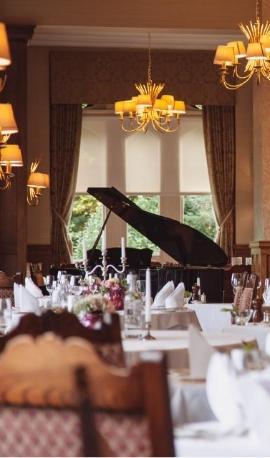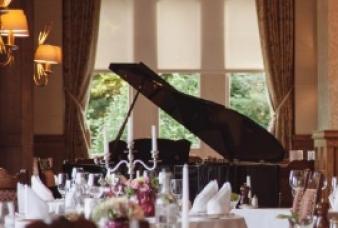We are delighted to share this blog about our fantastic May coffee morning, hosted by the wonderful Alexis from The Sussex Wildlife Trust.
The Sussex Wildlife Trust, part of Wildlife Trusts, is a charity dedicated to the support of local wildlife, teaching and connecting communities with nature and encouraging people to engage with their neighbouring wildlife.
Did you know?
Do you know why is the Ashdown Forest is called 'Ashdown Forest'?
The soil of the forest is sandy, where exposed it looks like ash and is hard packed. Hence 'Ash' for the soil and 'down' is a small hill, of which there are many throughout the forest.
Gardening for Wildlife
There are 15 million gardens in the UK - that's a lot of privately owned outdoor space; approximately 270K hectares, an area larger than the entire county of East Sussex.
A lot of these gardens interconnect and are essential to the survival of our wildlife.
The living landscape.
Your garden is a place to love and transform into your own tranquil space, full of colour, style and personality.
Whether you have a 'pocket garden' or a large countryside garden, there are some small changes that you may choose to do, which can help the local wildlife.
Urban landscapes.
A small patch of flowers can be invaluable, from road verges, allotments and pots or windowsill planters.
The hedgerows along paths and roadsides are also great for wildlife, offering shelter and food.
Planting your garden
Your garden is personal to you and the maintenance needs of your outdoor areas need to work for you. The best thing about wildlife gardening is that 'Wildlife gardening is relaxed gardening'; often less is more but at the same time, wildlife-friendly gardens don't have to be messy! You could also try a 'Kitchen garden' which are great for you and the wildlife.
Top Tip: When choosing your plants, look for the 'good for bees' or 'good for insects and bugs' - this means they've been grown without pesticides or harmful methods and are good for wildlife going forward.
No need to be too tidy... Please leave some plant heads. Don't sweep up all leaves. Some weeds are lovely - leaving things for a bit longer can help.
What to choose?
Perennial plants are often better as their root systems make the plants more durable and they come back year on year, saving you the cost of bedding plants and the work of planting each year. Choose the colours and flowers you like and take a look at the various types available, i.e. Lavender, they flower at different times of the year and in different colours.
Developing your garden is a marathon, not a sprint... the long game is the main thing to think about.
Top tip: Consider what plants seed at various times of the year. This not only ensures beautiful flowering for more seasons it also helps provide food throughout the year to bees, butterflies and other insects; extending into the 'shoulder periods of the year' (Spring and Autumn). With changes happening in temperature and seasons, there will be a change in some plants doing better than others.
When possible choose single flowers (these tend to be older breeds) over double as they are often less hybridised and are easier for insects to land on and access food. It's also worth noting that although roses are beautiful, these days many of them have been hybridised so are often sterile and don't produce the food you would expect for bees and insects.
Lawn
Dandelions, daisy's and clover are all great for nature in your lawn! Cut the lawn a bit less and leave longer edges.
Mow your grass a little taller.
Birds
If you have cats and would like to put out a bird feeding station, please think about where your bird feeder is. Try to locate them somewhere your beloved cats, or neighbours cats would not go or reach.
To encourage small songbirds to feed at your feeder, it's helpful to locate the feeder near the edge of the garden, somewhere where there's a bit of shelter and protection from 'rapture' birds.
Hedges and climbers are great for nesting birds such as honeysuckle and dog rose. When trimming trees and hedges, try to do this in the winter and not in the spring and summer, to avoid disturbing nesting birds.
As a fun activity - insect and bird boxes are a great activity to do with children and are super for insects, bees and birds. Click Here for a how-to blog.
Hedgehogs
Hedgehogs - install a hedgehog 'superhighway' - a CD case size hole in the bottom of your fence, either side and back of the garden. This is small enough that a cat may not fit through but is a good size for a hedgehog. This can make a huge difference by connecting all the gardens and reducing the impact to their natural hunting areas. Hedges eat slugs which come out at night, so this is another great way to help control these pests.
Did You Know?
Toad populations are down 50% and the Hedgehog population is down 30% in the UK.
Ladybirds
England's most common ladybird is the 7 spotted ladybird. You may have also heard about the 'Harlequin Ladybird', which is said to be killing off our native ladybirds and looks very similar to our common ladybird.
At the moment experts are just monitoring the Harlequin Ladybird's presence.
Bees
There are 24 species of bumblebees, 6 of which are under threat. This is a lot due to the use of pesticides, as we mentioned common garden pesticides can be really harmful.
Miner bees. These bees have an annual life cycle and if you have any in your garden, they will most likely die off in the winter.
They will often burrow into lawns, if you can, please do leave them 'bee'...
Solitary bumblebees 'masonry bees' burrow into stone walls or old masonry and often live near each other but on their own, like human neighbours.
Spring flowers are best for bees.
Butterflies and Moths
What's good for bees is normally great for butterflies too.
Moths tend to come out at night so plants which smell and looks good at night (often white and yellow plants) are great.
Mint - which is also good for bees.
French marigold - plant near tomatoes - helps distract bugs from the tomatoes.
Plant veg with flowers to distract them from your vegetables.
Primroses are great for moths - with an evening sent.
Clovers are great too. Runner beans have great flowers for butterflies.
Native or non-native...?
A 4-year project by the RHS looked at which is best for wildlife. During the height of summer, native species did attract more insects. Although, in the 'shoulder seasons' (Spring & Autumn) when the native summer flowering is normally done, non-native plants provided nectar sources much longer and had a longer life. So a mix of native and non-native is a great solution.
Go Organic & sustainable
Going Organic & being sustainable can be beneficial for your garden and is best for nature. The chemicals we use in our garden get into the food chain and soil, affecting songbirds and bees.
Of course, the chemicals we do use are often for a good reason, such as protecting plants from being eaten by a range of critters such as slugs, snails and aphids.
A simple and easy switch you can do is to look out for organic pesticides instead of harsher chemical versions.
Gardening is about balance, so whatever chemicals you are putting on your plants, be aware of the amount of chemicals, organic or not that you are using.
Chemical-free ways to deal with garden nuisances such as slugs & snails (which can be an ongoing battle, especially if you have soft-leaved plants or vegetables) include:
Beer Traps - These can be effective, non-toxic method, but it does seem to work best on greedy slugs and snails which drink too much beer and they can't get out.
Barricades - For slugs and snails - although this doesn't always work. Research has shown that some slugs can eat various man-made materials. Old tea leaves don't work to keep away slugs and snails, they don't eat masking tape but will eat paper labels.
Protecting your vegetables from moths & butterflies:
Try planting flowers with and near your vegetable and fruit plants which helps distract these creatures. i.e. Plant French marigold near tomatoes - helps distract bugs from the tomatoes.
Alexis likened Snails as the 'Goat' of the Gastropods.
Aphids
If you spray for aphids - this goes into the food chain and can kill ladybirds. Try a really soapy water spray, this stops things sticking to it.
Another option is to introduce Nematodes - natural predators for pests.
Wooden furniture
If you are looking to buy new wooden garden furniture, look out for the 'FFC' label, indicating sustainably sourced wood.
Ponds & Water
Most water residing wildlife tends to live in about 60cms of water. A metre across and 60cm deep pond could be an essential addition to your garden and very helpful to many species. From the life cycle of a dragonfly, frogs & toads, to being a water and bath source for birds, who will also be attracted by the natural food (insects) which are also attracted to the pond
Around the edge of the pond to encourage life, create shallow sides so things can climb out. Plants and pond leaves can be so helpful in providing shelter and oxygenation to the water.
Even just a saucer of water in your garden can be helpful for wildlife.
When watering your garden, using rainwater collected in pots or a waterbutt is ideal. Often rainwater is actually better for your garden and plants compared to tap water, which contains chemicals such as chlorine from the cleaning process at water treatment plants.
Composting
If you don't want your own compost bin in the garden composting bin are often free or cheap from the council and are collected.
For your garden, a wooden compost bin with holes works faster than the large plastic ones and will often be more pleasing to the eye. You can always hide your compost bins with wooden structures or climbers...much prettier.
Turning compost is fast... the worms will find your bin and help.
In your compost you can include:
Animals waste inc. chickens...
Cat litter (note the clay bits can sometimes be a bit tricky.)
Deadwood - which in general in your garden is great for nature such as fungi and insects.
Did you know?
There are 29 species of earthworm and they can breathe in water through their skin!
Photographs: Are each copyright to individual photographers C.O. Sussex Wildlife Trust.










